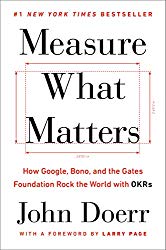“Measure What Matters” is a book by the investor and venture-capitalist John Doerr on using OKRs (Objectives and Key Results) and CFRs (Conversations, Feedback, and Recognition) to drive excellence and growth in a company. These have been replacing MBOs (Management By Objectives) and KPIs (Key Performance Indicators) in many companies. OKRs were pioneered by former Intel CEO Andy Grove, but have been proselytized by the author over the years. They were made famous by their adoption and continued use at Google as it grew at an unprecedented scale. If you want to know more about OKRs and how to apply them at your company, this is the book for you.
It is an adage in management that “if you cannot measure it, you cannot improve it” (interestingly, a quote wrongly attributed to W. Edwards Deming, who actually said something to the opposite effect). An OKR combines a concrete, action-oriented Objective (the WHAT) with a few measurable, verifiable, and time-bound Key Results (the HOW), the completion of which indicates the achievement of the Objective. A group defines OKRs at the beginning of the relevant time-period (say, a year or a quarter) and then works towards achieving those Objectives by delivering the respective Key Results.
OKRs are defined at every level of the organizational hierarchy – from those for the entire company down to those for an individual employee – for a specific time-period and in such a way that these are all aligned with each other and committed to by the stakeholders at the beginning of the time-period. They are transparent across the organization so that everyone can see how the entire organization is working towards achieving the shared goals. They are tracked periodically and reviewed at the end of the time-period, but employee-compensation is not tied to them.
CFRs replace annual performance-reviews with a continuous process of having crucial conversations, providing timely feedback, and rewarding good performance. Managers are encouraged to have regular one-on-one conversations with their team-members in which they both provide and receive feedback, review growth-plans, address concerns, etc. This eliminates recency bias in annual performance-reviews. It allows managers to provide critical feedback and recognition when it is most effective, rather than at the end of the year when it could be too late.
The book explains the rationale behind OKRs and CFRs, how to use them effectively, and contrasts them with MBOs and KPIs. The bulk of the book deals with OKRs though, with CFRs somewhat cursorily addressed in the latter portion of the book. It provides several case-studies from across the industry to illustrate how different companies have adopted OKRs, what they have learned from it, etc. (I felt that these case-studies were the weakest part of the book, as after a while they got quite repetitive in essence and got entangled in irrelevant details.) At the end of the book is a “Google's OKR Playbook” that provides some concrete guidelines on creating OKRs as adopted by Google. There is a companion web-site as well providing more resources and updates for those interested in adopting these methods.
Having used OKRs for several years at work, I have seen both the good as well as the bad parts of adopting them. For cross-functional, distributed teams that work across various time-zones, it is particularly important to get early alignment and commitment across the teams for useful OKRs to be created and to avoid costly readjustment of priorities and reallocation of resources later. The management at an organization has to have enough trust in their employees and provide them sufficient autonomy for OKRs to be effective in boosting performance. As the emphasis is on having fewer, focussed OKRs that deliver measurable value to the company and manage to stretch the team beyond its comfort-zone, maintenance and polishing work often gets dropped leading to reduced productivity in the longer run.
Sometimes, it is not really possible to measure some important things, so people either do not put them as Key Results or worse, end up using the wrong metric just to make Key Results measurable. As someone once quipped:
Not everything that counts can be counted, and not everything that can be counted counts.
Or to use the full quote from W. Edwards Deming referenced earlier:
It is wrong to suppose that if you can't measure it, you can't manage it – a costly myth.
So beware of this caveat while adopting OKRs or any other measurement-oriented (aka “data-driven”) methodology.
That said, the transparency and the focus brought about by properly adopting OKRs and CFRs are particularly effective in showing a worker in the trenches how their work eventually matters to achieving the overall goals of the company and to make the entire company more productive. If you are not already using OKRs, take a look at this book and decide for yourself.
